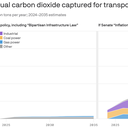Senate energy bill could help U.S. carbon capture take flight

The Senate's climate deal could bring scale-up of carbon capture in heavy industries and power after years of limited momentum and false dawns.
Driving the news: It provides a long-term extension of time for projects to qualify for existing credits and expands their application and value.
- And it boosts subsidies for nascent "direct air capture" tech, but that's not slated to start sucking big CO2 volumes from the atmosphere anytime soon.
The big picture: New analysis from the Princeton-led REPEAT Project looks at the subsidies combined with demonstration funding in the bipartisan infrastructure law.
- They see it becoming a "viable economic option for the most heavily emitting industries" like steel and cement production, oil refineries, as well as power generation.
- The analysis sees carbon capture providing roughly one-sixth to one-fifth of the total CO2 cuts from the new bill, Princeton's Jesse Jenkins said via email.
- REPEAT's model shows the sector simply won't take flight in the U.S. without the new bill (check out the graphic above).
Why it matters: Trapping CO2 can complement climate-friendly energy sources like renewables, storage and clean hydrogen.
- But high costs and other barriers have long thwarted major deployment, though the global project pipeline is growing.
What they're saying: Ben King of the Rhodium Group, a research firm, said they also see the incentives driving "meaningful deployment."
- That's especially true for heavy industry, while renewables' cost advantages (also aided by the bill) mean Rhodium sees few capture retrofits in the power sector.
- King said their forthcoming analysis of the carbon capture provisions generally tracks with REPEAT's take through 2030.
- From there, Rhodium sees even more growth in heavy industry, while REPEAT shows a post-2030 plateau, he said in an interview.
Yes, but: Nothing's guaranteed with carbon capture, which will require a build-out of transport, approval of storage sites and more. REPEAT's study offers several caveats.
Catch up fast: The bill has many new and expanded subsidies for renewable power, battery storage, electric cars and much more.
- REPEAT sees it bringing the U.S. close to President Biden's pledge under the Paris Agreement of cutting emissions in half by 2030 compared to 2005 levels.
- It would close roughly two-thirds of the gap between existing policy and the target, they estimate.